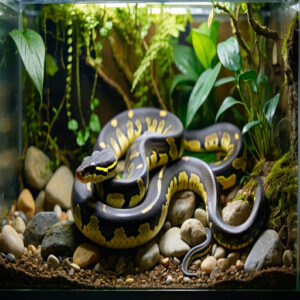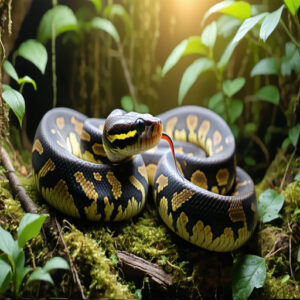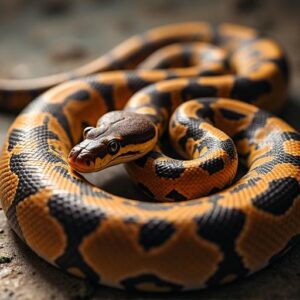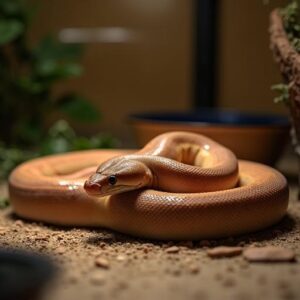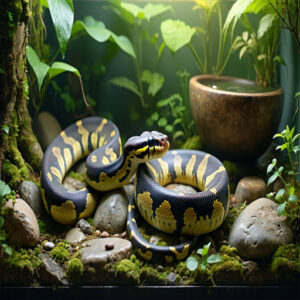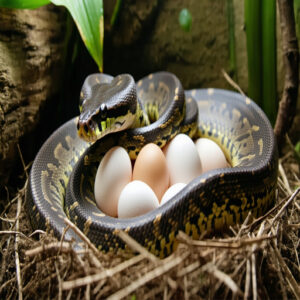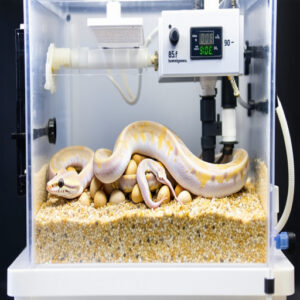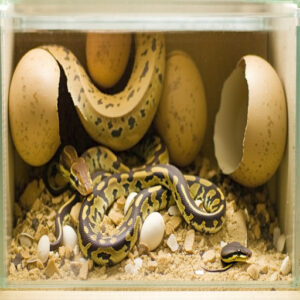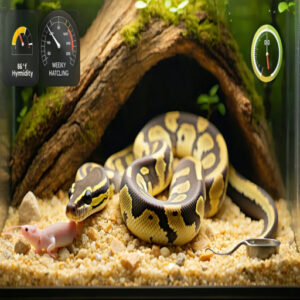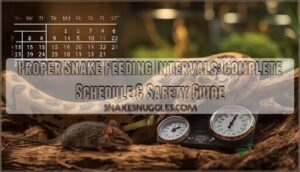This site is supported by our readers. We may earn a commission, at no cost to you, if you purchase through links.
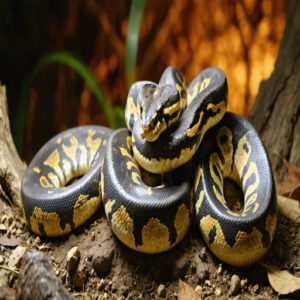 Breeding ball pythons for beginners is all about preparation and patience.
Breeding ball pythons for beginners is all about preparation and patience.
Start with a healthy female over 1,500 grams and three years old, paired with a male at least 700 grams and one year old.
Mimic their natural African habitat by gradually lowering nighttime temperatures to the mid-70s°F and maintaining daytime highs in the 80s°F.
This seasonal cooling triggers their breeding instincts.
Introduce the male and female, keeping an eye out for signs of copulation, which can take hours or days.
After mating, females typically lay 4-6 eggs within 30-50 days.
Ready to learn about incubation and hatchlings? Let’s go!
Table Of Contents
- Key Takeaways
- Preparing for Ball Python Breeding
- How to Breed Ball Pythons Successfully
- Ball Python Mating Process and Egg Laying
- Egg Incubation and Hatchling Care
- Breeding Ball Pythons for Beginners Essentials
- Frequently Asked Questions (FAQs)
- How Often Should I Feed My Hatchlings?
- What is the Temperature Range for the Incubator?
- Is There a Difference in the Incubation Period for Female and Male Eggs?
- How Can I Tell if a Female Ball Python is Ready to Breed?
- How do you breed ball pythons for beginners?
- What month do you start breeding ball pythons?
- How to tell if your ball python is ready to breed?
- How long do you leave ball pythons together to breed?
- How old do ball pythons have to be to breed?
- How to breed ball pythons successfully?
- Conclusion
Key Takeaways
- Start with healthy, mature ball pythons—females should weigh at least 1,500 grams and be 3 years old, while males need to hit 700 grams and 1 year.
- Mimic natural winter cycles by gradually lowering nighttime temperatures to the mid-70s°F, while keeping daytime highs in the 80s°F, to trigger breeding.
- Monitor for successful mating by observing locking behavior, and maintain stress-free conditions throughout the process.
- Incubate eggs at 85°F with 90-100% humidity for 50-60 days to ensure healthy hatchlings, and provide well-prepared enclosures for their growth.
Preparing for Ball Python Breeding
You’ll need healthy adult ball pythons weighing at least 1,500 grams for females and 700 grams for males, with both being over three years old to start your breeding journey.
Before you introduce your snakes, you’ll want to set up the right temperature cycles that mimic their natural winter cooling period, dropping the temperature to around 60°F to trigger their breeding instincts.
This will help ensure a successful start to your breeding program with healthy adult ball pythons.
Conditioning and Cycling
Just like a pro chef preps their kitchen, you’ll need to master the python breeding cycles through careful temperature control.
Start your breeding triggers by lowering nighttime temperatures to the mid-70s°F in late October.
- Drop daytime temperatures to high-80s°F while maintaining 10-12 hour lighting cycles
- Create cooling methods gradually over 4-6 weeks
- Monitor humidity management at 80-90% during the cycle
Understanding the temperature regulation is essential for a successful breeding process.
Your ball python reproductive behavior depends on nailing these seasonal shifts.
Selecting Healthy Adult Ball Pythons
Choosing healthy adults is the backbone of ball python breeding for beginners.
For females, a minimum weight of 1,500 grams and at least three years of age guarantees readiness, while males need to hit 700 grams and mature by one year old.
Look for vibrant scales and a curious, active demeanor—Snakes in top health are more likely to thrive.
Regular breeding health checks are imperative to avoid risks like egg binding.
Prioritize genetic diversity and strong Ball Python Morphs for successful breeding outcomes.
Snake weight limits and age factors aren’t optional—they’re essential.
To achieve the best breeding results, understanding the principles of choosing healthy snakes is indispensable for selecting the right ball pythons.
Mimicking Natural Habitat Cycles
Getting into ball python breeding for beginners, recreating their African savannah roots is key.
Climate simulation—here’s where temperature control, humidity levels, and lighting cycles step up.
Shift their enclosure’s conditions to mimic seasonal changes and trigger breeding behavior. Think of it like setting the mood—right daylight hours, night temps, and moisture levels keep them happy and ready.
Try these tips:
- Temperature cycling: Gradually lower nighttime temps to mimic natural changes.
- Humidity control: Keep levels stable to promote health and egg development.
- Lighting cycles: Shorten days for breeding season vibes.
- Environmental adaptation: Make certain enclosure tweaks feel natural for your snakes.
Temperature Cycling
Ball python breeding for beginners starts with temperature cycling—it’s like setting the stage for nature to take its course.
Gradually lower nighttime temps to the mid-70s Fahrenheit for three weeks before introducing your pair.
Keep daytime temperatures steady in the high 80s.
These fluctuations mimic seasonal cooling, promoting follicle growth in females.
Thermal control matters here: avoid sudden drops that can stress your snakes.
Use reliable heat sources like under-tank heaters or ceramic heat emitters to prevent overheating or uneven warmth.
Monitor with a python breeding temperature range chart for consistency.
And don’t forget—humidity levels play a supporting role, so maintain balance.
Temperature cycling guarantees healthier snakes and better clutch results, setting the tone for success.
Preparing Equipment and Enclosures
Before anything, get the right ball python breeding equipment in place for success:
- Enclosure Design: Go with secure, well-ventilated setups that prevent escapes.
- Substrate Selection: Use aspen or cypress mulch to lock in moisture without mold.
- Humidity Control: Equip your ball python enclosure with a reliable hygrometer and mist when needed.
Proper ball python enclosures are essential for maintaining the right environment.
Think of it as their five-star hotel!
How to Breed Ball Pythons Successfully
Breeding ball pythons successfully starts with pairing healthy snakes at the right age, weight, and conditions to encourage natural behaviors.
By understanding their courtship habits, ensuring proper temperature cycling, and recognizing signs like ovulation, you’ll set the stage for a successful breeding season.
Introducing Males and Females
Introducing new snakes during python mating season starts with the male introduction into the female’s enclosure.
Observe courtship behavior—males may use their spurs to nudge females gently, and look for signs of female readiness, which is key; breeding cues include restlessness or coiling.
Stay patient—compatibility isn’t instant, and python behavior varies, so it is crucial to balance observing ball python mating pairing with ensuring the snakes stay stress-free and healthy.
Locking Position and Successful Mating
Spotting the male’s courtship behavior helps gauge his interest.
Watch as he uses his spurs to stimulate the female—nature’s way of testing snake compatibility.
When ready, the male enters the locking position, inserting one hemipene into the female.
Here’s how to increase the odds of breeding success:
- Verify stable temperatures in the breeder enclosure.
- Monitor mating techniques closely to confirm locking.
- Leave them undisturbed during locks, which last 4-48 hours.
- Pair compatible snakes during the snake mating season.
- Track behaviors like coiling or prolonged closeness.
Patience pays in ball python breeding!
Female Ovulation and Shedding
Keep an eye out for ovulation signs—your female’s midsection will swell noticeably, looking almost “lumpy.”
Her color may brighten, often called a "pre-ovulation glow."
Within weeks, she sheds—a shedding process that’s part of the reproductive cycle.
This is the pre-lay shed, signaling egg development.
At this stage, make certain she’s at her ideal breeding weight and provide stress-free care.
Understanding ball python breeding is vital for a successful reproductive cycle.
Multiple Lock Attempts and Courting Behavior
Once females show ovulation signs, male introduction sparks fascinating snake mating rituals.
Courting signs like tail whipping or spurs tickling her sides often precede locking.
Multiple lock attempts may help reinforce success during breeding cycles.
Here’s the strategy:
- Watch Closely: Verify proper locking techniques without female stress.
- Avoid Overcrowding: Prevent male-on-male fighting.
- Stay Patient: Ball python behavior relies on natural timing.
Ball Python Mating Process and Egg Laying
Understanding the ball python mating process and egg laying is key to breeding success.
You’ll learn how to identify essential behaviors like courting, ovulation, and restlessness, ensuring you’re fully prepared when your female lays her clutch.
Pre-lay Behavior and Restlessness
When your female ball python starts refusing food and acting restless, it’s a big clue she’s preparing to lay.
Watch for pre-lay behavior like coiling around her water bowl and a pre-lay shed.
This nesting instinct signals ovulation success.
Keep an eye out for signs of egg binding, a rare but serious issue.
Timing is key in python breeding cycles.
Clutch Size and Incubation Conditions
When breeding success is your goal, clutch management is key.
Know that ball pythons lay 4-10 eggs, and their egg quality depends on proper incubating.
Nail these incubation tips:
- Hold the temperature steady at 85°F.
- Maintain 90-100% humidity.
- Use a thermometer and hygrometer to monitor conditions.
- Avoid drafts or sudden changes during the incubation period.
Understanding optimal incubation conditions is vital for a successful hatch.
It’s all about consistency!
Oviposition and Removing Eggs
Oviposition, or egg laying, is an exciting step in ball python breeding.
Your female will deposit her clutch—typically 4-8 eggs—after ovulation.
Post oviposition care is essential for healthy incubation and a stress-free process.
Here’s how to manage it:
- Look for the pre-lay shed; eggs usually come 30-50 days after.
- Gently remove the female after egg laying—she might still feel protective.
- Mark each egg’s top to maintain orientation during clutch removal.
- Transfer eggs carefully into your incubator to optimize conditions for hatching.
Preparing for Incubation
Think of your ball python eggs as delicate spa guests.
Start with a sealed egg box filled with perlite or vermiculite, ensuring ideal egg humidity.
Place it in an incubator set to 85°F—keep that incubation temperature steady.
Monitor daily during the 60-day incubation period for python eggs.
Proper incubator setup and ball python egg incubation are key for healthy hatchlings and smooth breeding cycles ahead.
Egg Incubation and Hatchling Care
Getting ball python eggs to hatch successfully means ensuring the right temperature, humidity, and care throughout incubation.
Once the hatchlings emerge, you’ll need to provide individual enclosures with the right setup to help them thrive from day one, which involves proper care.
Incubation Setup and Ideal Conditions
Once your female has laid her clutch, it’s time for egg incubation.
Set up an incubator at an incubation temperature of 85°F with a humidity level between 90-100%.
Use vermiculite or perlite as your substrate, ensuring it holds moisture but drains well.
Humidity control is vital—dry eggs are a no-go!
Add proper ventilation systems to prevent mold and unhealthy conditions.
Avoid egg turning; keeping their position steady is critical.
For heat sources, consistent temperature control keeps your incubation period on track and those eggs thriving.
Investing in a reptile egg incubator is essential for successful breeding.
Hatching Process and First Shed Cycle
After around 60 days of incubation, the magic begins—your ball python hatchlings start their hatching process.
You’ll notice egg pipping, where neonates use their egg tooth to break free.
Once they’re fully hatched, their first shed cycle typically occurs within a week.
This shed is vital for their Neonate Health as it sets the stage for proper growth and development.
Here’s what to watch for:
- Shell fragments should be removed once hatching’s done.
- Maintain warm, humid conditions for Hatchling Care.
- Avoid handling them pre-shed.
- Observe closely for healthy shedding behavior.
Feeding and Enclosure Setup for Hatchlings
Hatchling ball pythons need cozy spaces to thrive.
Set enclosures at 85°F with 60% humidity for proper snake growth.
Keep décor simple—choose aspen or paper substrate while avoiding dampness.
For hatchling nutrition, serve pinkie mice weekly after the first shed.
Here’s a must-do list:
- Stable temperature
- Humidity Control
- Safe substrate
- Feeding schedule
Focus on stress-free ball python hatchling care!
Growth and Development of Ball Pythons
Your hatchlings will grow fast if you nail their care.
At birth, they’re just 12-18 inches but can hit impressive lengths as adults (up to 5 feet!).
Expect rapid growth early on, followed by slower but steady development.
Feed consistently and monitor their health—good reptile nutrition is key.
Each shedding marks progress, and size depends on their genetics and environment.
A well-cared-for ball python showcases fascinating growth patterns and stunning snake morphology.
Breeding Ball Pythons for Beginners Essentials
Breeding ball pythons starts with understanding their biology and creating a safe, natural environment for mating.
You’ll need to focus on selecting healthy adults, meeting age and weight requirements, and avoiding common mistakes that can impact their health.
Verifying Snake Sex and Genetic Testing
Sexing snakes is vital in ball python breeding.
Use probing or popping methods for accurate sex determination—don’t worry, practice makes perfect!
Understanding snake breeding genetics and inheritance is essential for predicting outcomes.
Verifying genetic markers guarantees ethical ball python breeding and avoids surprises later.
Python breeding tips like these improve snake identification and let you plan for spectacular morphs confidently.
Breeding Season and Age Requirements
Breeding ball pythons starts with timing and healthy, mature snakes.
The python breeding season 2024, typically November to March, mirrors their natural breeding cycles.
Female readiness depends on age (3+ years) and weight (1,500g), while males need to hit 700g and 1 year.
- Breeding Readiness: Confirm reproductive health and weight.
- Snake Maturity: Avoid rushing young or underweight snakes.
- Reproductive Health: Prioritize fresh water, clean enclosures, and proper feeding.
Common Breeding Mistakes and Solutions
Breeding mistakes happen, but you can dodge them by staying sharp.
Temperature swings, snake stress, and humidity hiccups can ruin plans fast.
Pairing too early? That risks egg binding and health issues.
| Outcome |
|---|
| Temperature swings |
egg binding
breeding
Follow these python breeding tips to avoid setbacks and keep your ball python breeding guide frustration-free!
Nutrition and Health for Breeding Ball Pythons
If you want healthy hatchlings, start with perfect ball python nutrition.
A pre-breeding diet isn’t just feeding—it’s preparation.
Aim for strong, plump snakes ready for the task.
- Track weights: Underweight snakes struggle to breed.
- Optimize nutrients: Feeding strategies matter; don’t skip supplements.
- Address gaps early: Prevent deficiencies before they derail breeding.
- Prioritize health checks: Include routine vet visits for Python Health Checks.
- Nurture balance: Nutrient balance fuels energy for egg production.
Dial in these snake breeding tips to guarantee success!
Frequently Asked Questions (FAQs)
How Often Should I Feed My Hatchlings?
Did you know hatchlings can double their weight in their first year.
Feed them every 5-7 days, offering frozen-thawed prey about their body width.
Regular meals help build healthy growth without overwhelming their tiny bellies.
What is the Temperature Range for the Incubator?
You’ll want your incubator set between 88-90°F for the best hatching results.
Too cold? Your eggs could fail. Too warm? Embryos mightn’t develop right.
A reliable thermometer guarantees conditions stay just perfect.
Is There a Difference in the Incubation Period for Female and Male Eggs?
There’s no difference in incubation time for male or female ball python eggs.
Both typically hatch within 50-60 days, provided you maintain steady temperatures and humidity.
It’s nature’s way of keeping things fair and simple!
How Can I Tell if a Female Ball Python is Ready to Breed?
You’ll know she’s ready when she’s at least 3 years old, weighs 1,500 grams or more, and looks healthy with vibrant scales.
Watch for curiosity, good appetite, and steady behavior—big signs she’s primed.
How do you breed ball pythons for beginners?
It’s funny how nature sets the stage—ball pythons breed when cooler temps mimic winter.
Prep healthy adults, lower nighttime temperatures, and watch courtship unfold.
Successful mating leads to eggs that require precise, warm incubation.
What month do you start breeding ball pythons?
You’ll typically start breeding ball pythons in late October to early November.
Cooler temperatures mimic winter, triggering their breeding instincts.
Pair the snakes carefully, and watch for courtship behaviors like tail wagging and “locking” sessions, which can indicate successful courtship behaviors.
How to tell if your ball python is ready to breed?
Ironically, breeding readiness isn’t about romance—just weights and health.
Your male needs at least 700g and the female 1,500g, with vibrant scales and active behavior.
If they’re three years old, they’re likely good to go!
How long do you leave ball pythons together to breed?
You can leave ball pythons together for breeding until they "lock," which can last 4 hours to 2 days. Afterward, separate them to prevent stress and reintroduce the male if needed later.
How old do ball pythons have to be to breed?
Your ball pythons need to be at least 3 years old to breed.
Males should weigh 700+ grams, but females must hit 1,500-1,700 grams to safely produce eggs.
Breeding smaller females can risk their health.
How to breed ball pythons successfully?
Start by ensuring your pythons are healthy, mature, and well-fed.
Mimic winter by cooling their enclosure, then introduce pairs carefully.
Observe for mating signs, incubate eggs properly, and maintain ideal temperatures to encourage successful hatching.
Conclusion
Breeding ball pythons for beginners takes preparation, patience, and attention to detail.
From selecting healthy adults to setting up the perfect incubation conditions, every step matters.
Stay consistent with temperature cycling, monitor their behavior closely, and see that their habitat mimics nature’s cycles.
Remember, successful breeding is about caring for your snakes’ health first, with commitment and a focus on their well-being.
With commitment and a focus on their well-being, your ball python breeding journey can be as rewarding as watching hatchlings thrive.

